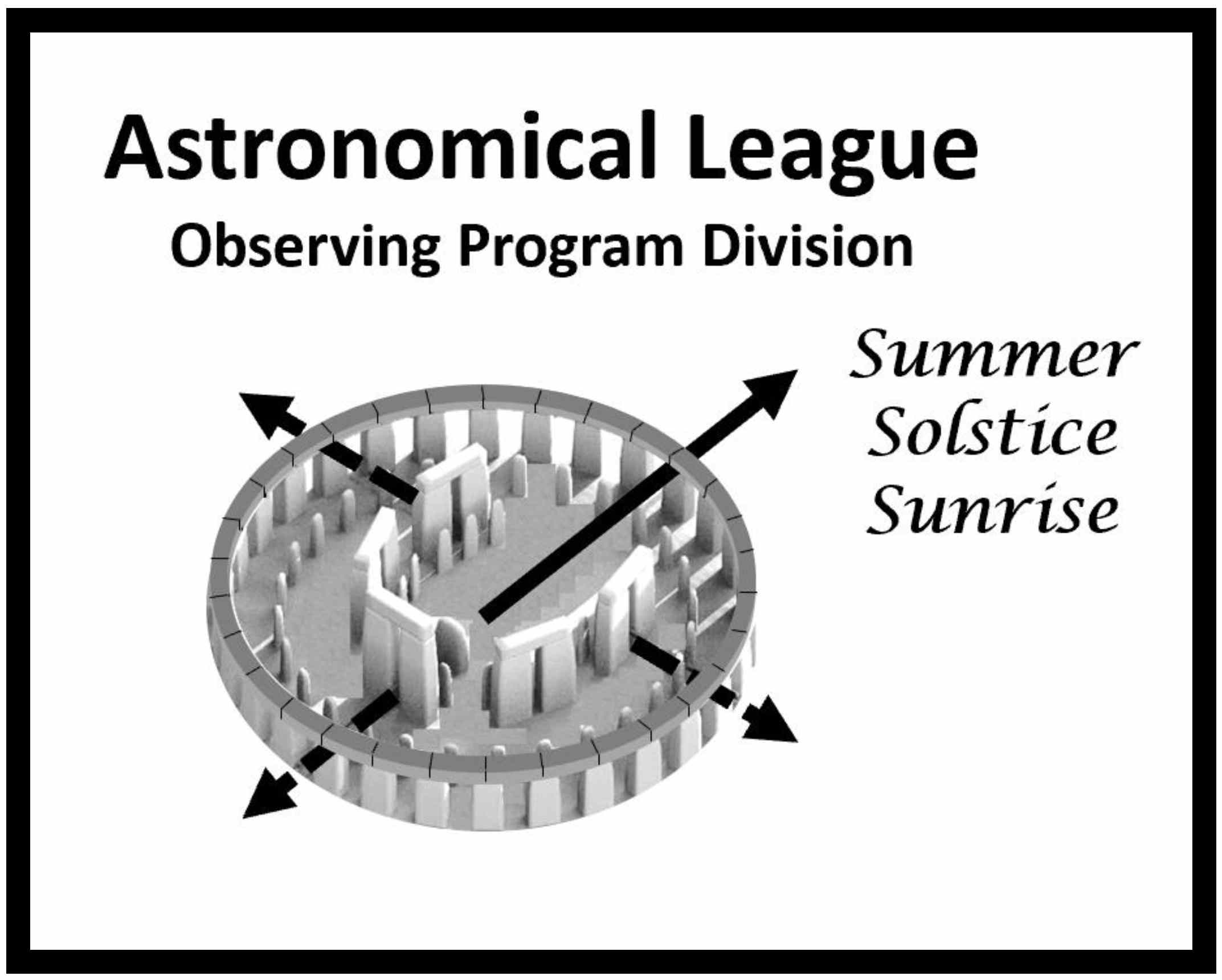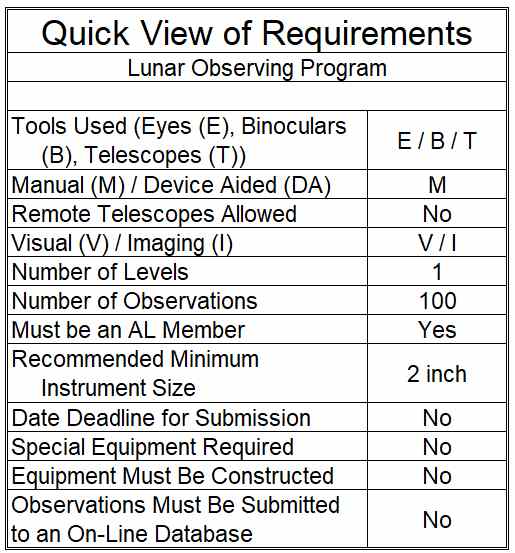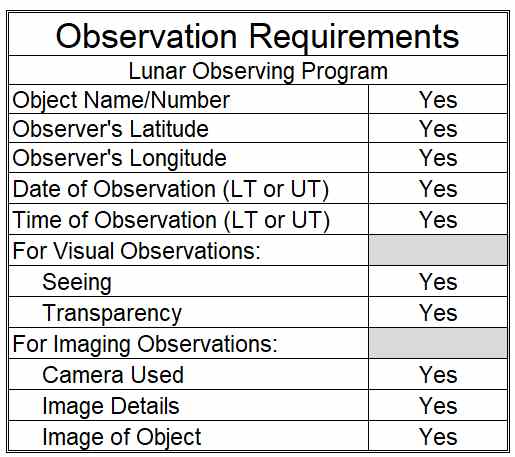Lunar Observing Program Coordinator:Charles E. Allen, III |
  |
IntroductionWelcome to the Astronomical League’s Lunar Program. The Lunar Program introduces amateur astronomers to that object in the sky that most of us take for granted, and which deep sky observers have come to loathe. But even though deep sky observers search for dark skies (when the moon is down), this program gives them something to do when the moon is up. In other words, it gives us something to observe the rest of the month, and we all know that the sky is always clear when the moon is up. The Lunar Program also allows amateurs in heavily light polluted areas to participate in an observing program of their own. This program is well suited for the young, inexperienced observer as well as the older observer just getting into our hobby since no special observing skills are required. It is well balanced because it develops naked eye, binocular, and telescopic observing skills. Finally, the Lunar Program was created as a project that can easily be done by schools and school children, especially those in the inner city. |
 |
Note: There are optional requirements that may be substituted for the regular requirements at the obsersver’s discretion
Levels of the Lunar Observing Program
Lunar Eyes Only Certification: This is a partial certification available for the Lunar Observing Program. For those completing the 18 Naked-Eye requirements a certificate is available. It is suitable to meet the requirements of the For Your Eyes Only Observer Award, but not the other Master Observer Progression Awards. No telescope or binocular observations may be included in the Eyes Only Lunar Certification.
Lunar Binocular Certification: This is another partial certification available for the Lunar Observing Program. For those completing the Naked-Eye and Binocular requirements (which may include replacement by optional requirements) a certificate is available. It is suitable to meet the requirements of the Binocular Master Observer Award, but not the other Master Observer Progression Awards. No telescope observations may be included in the Binocular Lunar Certification.
Lunar Regular Certification: This is the traditional visual certification. Observations are typically done visually, but this certification may include some observations done through imaging. 100 observations are required (may include the optional requirements). A pin and certificate will be awarded.
Lunar Imaging Certification: It is also now possible to earn your Lunar certification through imaging. The list of requirements is the same. You need to use the log to record dates and times when you imaged the features. The images can be submitted, but it is preferred that you post them on a website and include the website address in your submission. The images should include information on the exposures and the number of images that were stacked. Each image should indicate the specific feature(s). More than one feature may be included on the same image as long as they are all clearly visible and indicated. You may do this certification both ways and receive two certificates, but only one pin will be awarded.
Definition of Binoculars Allowed for Binocular Observations and Certification
The Astronomical League defines a binocular telescope as an observing device with two optical tubes and two eyepieces, where the eyepieces can be replaced with eyepieces of different focal lengths. “Bino-Viewers” have a single optical tube, but two eyepieces. “Bino-Viewers” and Binocular Telescopes may be used in any Observing Programs that are telescope based. They may not be used in binocular programs.
Observing devices with two optical tubes and two eyepieces, where you cannot change the eyepieces, are binoculars. Binoculars may be used in any Observing Program requiring telescopes or binoculars. Most binoculars do not have sufficient magnification to replace telescopes.
Requirements and Rules
This certification is available to members of the Astronomical League, either through their local astronomical society or as members at large. If you are not a member and would like to become one, check with your local astronomical society, search for a local society on the Astronomical League Website, or join as a member at large .
| To qualify for the AL’s Lunar Observing Program certificate and pin, observe 100 features on the moon. These 100 features are broken down into three groups: 18 naked eye, 46 binocular, and 36 telescopic features. Any pair of binoculars and any telescope may be used for this program. As a matter of fact, to prove that the Lunar Program could be done with small apertures, we used 7×35 binoculars and a 60mm refractor. So, as you can see, this program does not require expensive equipment. Also, if you have problems with observing the features at one level, you may go up to the next higher level. In other words, if you have trouble with any of the naked eye objects, you may jump up to binoculars. If you have trouble with any of the binocular objects, then you may move up to a telescope. But if you have trouble with any of the telescopic objects, you are on your own. You will have to arrange your own time on the Hubble Space Telescope. Before moving up to the next higher level, please try to get as many objects as you can with the instrument required at that level. Finally, when using binoculars, we recommend that you tripod mount them for stability. |  |
We have made it as simple as possible to log your observations. Just list the instruments that you used where requested at the top of pages of the checklist, check off the features as you observe them in the “CHK” column, and then list the date, time, seeing, transparency, latitude, and longitude for when you observed the feature in the columns on the right-hand side of the checklist. That is all there is to it.
For information on which lunar features to observe, review the Lunar Observing Program (PDF file or Excel file).
The man in the Moon (etc.) features in the Moon have been updated to provide more options. Any four are required as part of the 100 observations. Pick your favorites, or why not go for all of them. (Only four will count towards certification.)
For those of you that still may have some trouble observing the 100 original features of the program, we have included 10 optional activities on the last page of the checklist. Each one optional activity counts as two of the standard observations , and may be substituted for those observations.
If you would like a good recommendation for a lunar map to use with this program, we suggest, for those of you on a budget, “Moon Map” (#59198X) by Sky Publishing Corp.. Sky Publishing Corp. can be reached at (888) 253-0230. There is also a wonderful free interactive tool for identifying features on the moon: https://sourceforge.net/projects/virtualmoon/
Submitting for Certification
| To receive your Lunar Program Certificate and award pin, simply send your observations along with your name, mailing address, email, phone number, club affiliation, and whom to send the certification to the Lunar Observing Program Coordinator.
If you are submitting for only the Binocular Certification or for the binocular and the regular certification at the same time, please be sure to indicate that on your submission. |
 |
If you are submitting for the Imaging Certification, please remember to mention that and indicate the location of your images. This will be indicated by an “I” appended to your certificate number.
Upon verification of your submission and of your active membership in the Astronomical League, your recognition (certificate, pin, etc.) will be sent to you or to the awards coordinator for your society, as you specified. Your name will also appear in an upcoming issue of the Reflector magazine and in the Astronomical League’s on-line database. Congratulations. Good luck with your next observing challenge.
IF YOU SUBMIT BY EMAIL AND DO NOT RECEIVE A CONFIRMATION EMAIL FROM ME WITHIN 48 HOURS, PLEASE NOTIFY ME BY PHONE OR TEXT. THANK YOU.
Lunar Observing Program Coordinator:
Charles E. Allen, III
4005 St. Germaine Ct.
Louisville, KY 40207
(502) 693-5504
E-mail: chuckallen@gmail.com
Notes:
Acknowledgements:
- We would like to thank Steve Nathan for creating this Observing Program for the Astronomical League and for manning the helm from 1995 to 2017. He did an awesome job and we will miss his leadership. Thank you Steve.
- We would also like to thank Nina Chevalier for her leadership as Coordinator of this Observing Program until 2020.She was another awesome Coordinator. Thank you Nina.
Looking for more Lunar Information and Opportunities?
- The Astronomical League Web Store has a great manual available with information for all three AL Lunar Observing Programs. It is called Carpe Lunam, and is available here.
- There is a certificate available to those who have completed the Lunar Observing Program called the Lunar Evolution Certificate. For more information, go to the web page by clicking here.
- There is also a Lunar-II Observing Program. Go to the web page by clicking here.
Links:
- Lunar Program Observing List: (PDF file or Excel file)
- The Man, Woman, and Rabbit in the Moon, and other Lunar Pareidolia – (PDF file)There are 12 different options and they are shown for the northern hemisphere observer as well as for the southern hemisphere observer.
- Find your Lunar Observing Program award



